Sebum is an oily, waxy substance produced by the sebaceous glands of the skin. These glands can be found all over the body, but the face, scalp, chest, and back have the highest concentration. Sebum is essential for healthy skin, but imbalances in its production can cause a variety of skin problems. This blog delves deeper into sebum, its causes, and viable treatments.
What is Sebum and Its Role in Skin Health
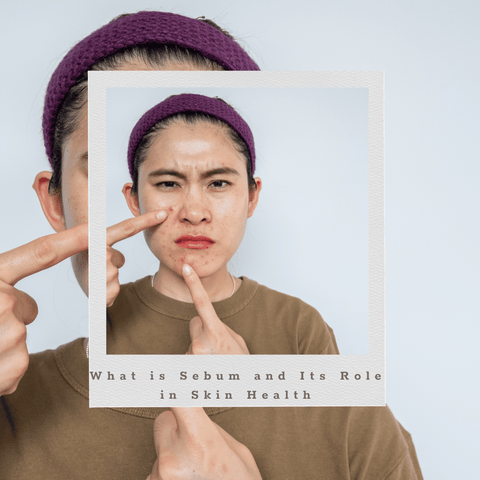
The sebaceous glands in the skin naturally produce sebum, a greasy substance. These glands are distributed throughout the body, with the greatest concentration on the face, scalp, chest, and back. Sebum is essential for skin health, performing activities such as moisturization, barrier function, acid mantle, hair health, antibacterial qualities, and anti-aging. While sebum serves these important roles in skin health, excessive sebum production can cause oily skin and contribute to skin problems like acne. Dry, flaky skin can come from sebum underproduction, which can occur with aging or certain medical disorders.
Definition and Function of Sebum
The sebaceous glands in the skin naturally produce sebum, a greasy substance. Sebaceous glands are present in hair follicles throughout the body, with the greatest concentration on the face, scalp, chest, and back. Moisturization, protection, acid mantle maintenance, hair health, antibacterial capabilities, lubrication, and anti-aging are all important functions of sebum in maintaining skin health. While sebum is necessary for skin health, excessive sebum production can cause oily skin and may contribute to skin problems such as acne. Underproduction of sebum, on the other hand, can result in dry, flaky skin. Proper skincare and hygiene practises can aid in the management of sebum levels and the promotion of healthy, balanced skin.
The Relationship Between Sebum and Skin Health
The link between sebum and skin health is complicated because sebum is essential for maintaining the skin's general health. However, an imbalance in sebum production can cause a variety of skin problems. Sebum has the following effects on skin health:
-
Moisturization: Sebum acts as a natural moisturiser, keeping the skin soft, supple, and hydrated. It forms a protective lipid barrier on the skin's surface, preventing excessive water loss and keeping moisture in the skin.
-
Barrier Function: Sebum acts as a barrier that shields the skin from external irritants, pollutants, and pathogens. This barrier protects the skin's integrity and overall health.
-
Acid Mantle Maintenance: Sebum contributes to the formation of the skin's acid mantle, which is slightly acidic and essential for maintaining the skin's pH balance. A balanced pH is essential for a healthy skin microbiome and prevents harmful bacteria from growing.
-
Hair Health: Sebum travels along hair follicles and coats the hair shaft, providing protection and hydration to the hair. This keeps hair shiny and soft.
-
Antimicrobial Peptides and Lipids: Sebum contains antimicrobial peptides and lipids that help protect the skin from bacterial and fungal infections, thereby contributing to skin health.
-
Anti-Aging: Sebum contains antioxidants such as vitamin E that can protect the skin from oxidative stress and free radical damage, potentially slowing the ageing process.
Causes and Factors Influencing Sebum Production
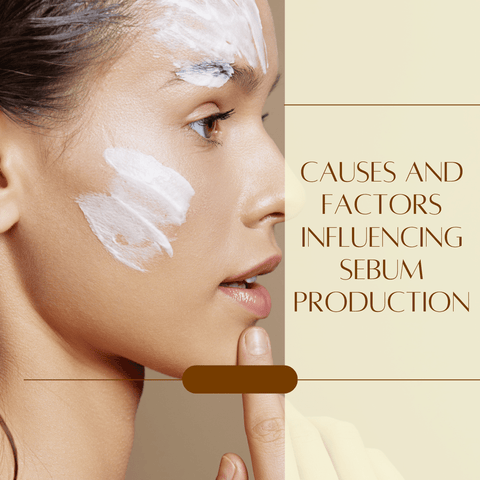
Genetics, hormones, nutrition, skincare practises, and environmental variables all have an impact on sebum production. Understanding the sources and factors that drive sebum production can assist individuals in efficiently managing their skin health. Some of the key causes and variables influencing sebum production are as follows:
-
Hormonal Changes: Hormonal changes influence sebum production significantly. Androgens, notably testosterone, increase the production of sebum by the sebaceous glands. Hormone variations throughout puberty, the menstrual cycle, pregnancy, and menopause can cause fluctuations in sebum production.
-
Genetics: Genetic factors can influence an individual's proclivity to produce sebum. Because of genetic factors, some people naturally produce more sebum than others.
-
Skin Type: The type of skin influences sebum production. There are four types of skin: oily, dry, combination, and normal. Sebum production is higher in oily skin types, while it is lower in dry skin types.
-
Environmental Conditions: Environmental factors can have an impact on sebum production. Humidity, temperature, and climate all have an impact on sebum production. Sebum production may increase in hot and humid weather, while it may decrease in cold and dry weather.
-
Dietary Factors: Diet can have an effect on sebum production. A high-glycemic diet, which includes sugary and processed foods, may increase sebum production and worsen acne in some people. Dairy products have also been linked to increased sebum production in some people.
-
Stress: Stress can cause hormonal changes that affect sebum production. Some people may experience more oiliness when under a lot of stress.
-
Skincare Products: The use of particular skincare products can affect the production of sebum. Harsh or overly drying products may cause an increase in sebum production as the skin attempts to compensate for moisture loss.
-
Medications: Some medications, such as hormonal birth control and corticosteroids, can have an effect on sebum production. If you suspect that a medication is causing skin problems, you should seek medical attention.
-
Age: Sebum production tends to be highest during adolescence (puberty) due to hormonal changes. It may decline with age, which for some people can result in drier skin.
-
Skin Care Routine: The way you care for your skin can have an impact on sebum production. Proper cleansing and skincare practises can aid in the management of sebum levels and the prevention of excessive oiliness or dryness.
-
Hydration: Proper hydration is critical for maintaining skin health. Drinking plenty of water can aid in the regulation of sebum production.
Hormonal Effects on Sebum Production
Hormones have an important function in controlling sebum production in the skin. The key hormone involved in this process is testosterone, which is present in both males and females but in larger concentrations in males. Here's how hormonal changes affect sebum production:
-
Androgens: Androgens are a class of male sex hormones, the most well-known of which is testosterone. These hormones induce the production of sebum by the sebaceous glands, which are found in hair follicles across the skin. Androgens bind to receptors on sebaceous gland cells, causing them to produce sebum.
-
Puberty: Androgen production increases throughout puberty in both males and females. One of the key reasons why teenagers frequently experience increased sebum production, resulting in oily skin and acne, is due to hormonal changes. These hormones cause the sebaceous glands to become more active.
-
Menstrual Cycle: Hormonal fluctuations during the menstrual cycle may influence sebum production. Some women may experience changes in the oiliness and breakouts of their skin in the days leading up to and during menstruation. These changes are frequently associated with hormonal fluctuations.
-
Pregnancy: Hormonal changes that occur during pregnancy may affect sebum production. Pregnancy hormones cause changes in some women's skin, such as increased oiliness or acne.
-
Menopause: The decrease in estrogen levels during menopause can cause changes in sebum production. Some women may experience drier skin during this time, while others may notice an increase in oiliness.
-
PCOS (Polycystic Ovary Syndrome): PCOS is a hormonal disorder that can cause elevated androgen levels in women. This hormonal imbalance can cause excessive sebum production, which can lead to acne and oily skin.
-
Hormonal Medications: Certain hormonal medications, such as hormone-containing birth control pills, can influence sebum production. Some contraceptive methods can help regulate sebum production and improve acne, while others may have the opposite effect.
-
Steroid hormones: Corticosteroids, which are prescribed for a variety of medical conditions, can have an impact on sebum production. Topical corticosteroids, which can also thin the skin, may have an indirect effect on sebum production.
Environmental Factors Affecting Sebum Production
Environmental variables can have an impact on sebum production in the skin. While hormones and genetics primarily control sebum production, environmental factors can exacerbate or moderate its effects on the oiliness and overall health of the skin. The following are some environmental elements that can influence sebum production:
-
Humidity: Excessive humidity can cause an increase in sebum production. When the air is humid, the skin perceives it as having enough moisture and produces less sebum to moisturise it. In low humidity conditions, on the other hand, the skin may produce more sebum to compensate for the lack of moisture in the air.
-
Temperature: Sebum production can be influenced by both hot and cold temperatures. Hot weather can cause increased perspiration, resulting in a buildup of sebum on the skin's surface. Cold weather can cause a decrease in sebum production, resulting in drier skin.
-
Climate: The climate of your geographical location can have a long-term impact on the sebum production of your skin. People who live in hot and humid climates may have more active sebaceous glands and thus oily skin, whereas those who live in cold and dry climates may have less sebum production.
-
UV Exposure: Prolonged exposure to ultraviolet (UV) radiation from the sun can harm the sebaceous glands of the skin. The skin may respond by producing more sebum as a defence mechanism. This can result in increased oiliness and the possibility of acne breakouts.
-
Pollution: Pollutants in the environment, such as particulate matter and airborne toxins, can harm the skin's health. These pollutants have the potential to clog pores and cause inflammation, thereby influencing sebum production and skin conditions.
-
Indoor Environment: Factors such as heating, ventilation, and air conditioning (HVAC) systems can have an impact on skin health. Indoor heating in the winter can cause dry skin, while excessive air conditioning in dry climates can aggravate oiliness.
-
Water Exposure: Frequent contact with water, particularly hot water, can strip the skin of its natural oils, including sebum. As the skin attempts to compensate, this can cause dryness and possibly increased sebum production over time.
-
Stress: Factors that can increase stress levels include high-pressure work environments and residing in polluted urban areas. Chronic stress may have an effect on hormone levels and sebum production.
-
Personal Care Products: The application of skincare and cosmetics to the skin can introduce a variety of substances, some of which may alter sebum production. Products that are harsh or irritating to the skin may activate the sebaceous glands, resulting in increased oiliness.
Genetic Predisposition and Sebum Overproduction
A genetic predisposition to sebum overproduction can result in disorders such as oily skin and acne. Here are a few examples of how genetics can influence sebum production:
-
Size and Density of Sebaceous Glands: Genetic factors can influence the size and density of sebaceous glands in an individual's skin. People with larger or more densely distributed sebaceous glands tend to produce more sebum. This genetic proclivity can result in naturally oily skin.
-
Hormonal Regulation: Hormone regulation, particularly androgens such as testosterone, can have a genetic component. High levels of androgens can stimulate the production of sebum by the sebaceous glands. Individuals who inherit genes that influence hormone regulation may be predisposed to having overactive sebaceous glands.
-
Enzyme Activity: Hormones are converted into active forms in the skin by enzymes. These enzymes' genetic variations can influence hormone metabolism and, as a result, sebum production. Some people may have genetic factors that increase enzyme activity, resulting in higher androgen levels and sebum production.
-
Inflammatory Response: An individual's inflammatory response to clogged pores and acne lesions can also be influenced by genetic factors. Some people may be genetically predisposed to heightened inflammatory responses, which can exacerbate and prolong acne.
-
Acne Susceptibility: Genetic factors can influence acne susceptibility. If a person inherits genes that predispose them to acne-prone skin, they may be predisposed to sebum overproduction and subsequent acne breakouts.
While genetics can predispose people to sebum overproduction and skin conditions like acne, other factors like hormonal changes, diet, skincare habits, and environmental factors can all play a role in the development and severity of these conditions. Managing sebum overproduction frequently requires a combination of strategies tailored to an individual's specific requirements. This may include using appropriate skincare products, eating a balanced diet, practising good hygiene, and, in some cases, consulting with a dermatologist who can recommend treatments and medications to address sebum-related skin issues.
Effects of Excess Sebum on the Skin
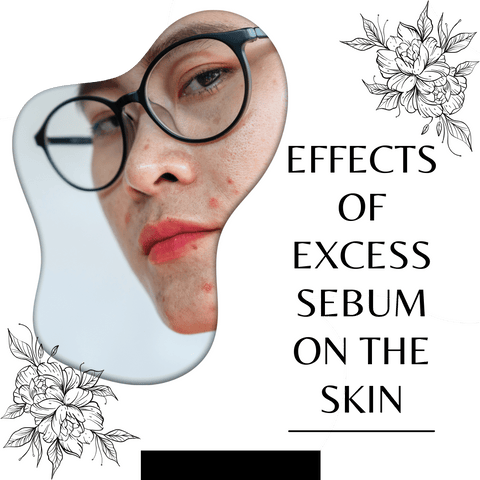
Excess sebum production, often known as seborrhea or oily skin, can have both beneficial and bad impacts on the skin. While sebum is essential for skin health, excessive sebum production can cause a variety of skin problems. Excess sebum has the following consequences on the skin:
Negative Effects of Excess Sebum:
-
Oily Appearance: The most noticeable effect of excess sebum is an oily or greasy appearance on the skin's surface. This can make the skin appear shiny and heavy.
-
Acne Formation: Excess sebum production is a major contributor to acne development. When sebum combines with dead skin cells and clogs hair follicles, acne lesions such as whiteheads, blackheads, pimples, and cysts form.
-
Pore Enlargement: Sebum buildup can cause pores to enlarge and become more visible, especially on the nose, chin, and cheeks. Enlarged pores may be more prone to clogging and thus contribute to acne formation.
-
Acne Scarring: If severe acne caused by excess sebum is not properly managed or treated, it can result in scarring. Acne scars can be difficult to treat and can affect the texture and appearance of the skin.
-
Sensitivity of the Skin: Oily skin can be more sensitive and prone to irritation. Excess sebum can trap debris and irritants, causing inflammation and redness.
Positive Effects of Sebum:
-
Natural Moisturiser: Sebum functions as a natural moisturiser, keeping the skin soft and hydrated. It forms a protective lipid barrier on the skin, preventing excessive water loss.
-
Barrier Function: Sebum acts as a protective barrier, shielding the skin from external irritants, pollutants, and pathogens. The integrity and general health of the skin are maintained by this barrier.
-
Acid Mantle Maintenance: Sebum helps to create the acid mantle, which is necessary for preserving the pH balance of the skin and promoting a healthy skin microbiome.
-
Hair Health: Sebum travels along hair follicles and coats the hair shaft, providing protection and hydration to the hair. This keeps hair soft and shinier.
-
Antimicrobial Peptides and Lipids: Sebum contains antimicrobial peptides and lipids that help protect the skin from bacterial and fungal infections, thereby contributing to skin health.
-
Anti-Aging: Sebum contains antioxidants such as vitamin E that can protect the skin from oxidative stress and free radical damage, potentially slowing the aging process.
Individuals with oily skin can manage the negative effects of excess sebum by following proper skincare practises such as regular cleansing, exfoliation, and the use of non-comedogenic (non-pore-clogging) skincare products. Additionally, seeking the advice of a dermatologist can provide tailored treatment options to address specific skin concerns related to sebum overproduction.
Sebum and Acne Formation
Sebum production plays a central role in the formation of acne. Acne is a common skin condition characterised by the development of various types of lesions on the skin, including whiteheads, blackheads, pimples, and cysts. Here's how sebum is involved in the process of acne formation:
-
Sebaceous Glands and Sebum Production: Sebaceous glands are tiny glands found in hair follicles all throughout the body. They are in charge of creating sebum, an oily material that moisturises and protects the skin. Sebaceous glands can become overactive and generate an excessive amount of sebum when exposed to hormones, notably androgens such as testosterone.
-
Excess Sebum and Hair Follicle Blockage: Excessive sebum production can cause oil accumulation in hair follicles. If the flow of sebum is obstructed by elements such as dead skin cells, sebum can become trapped in the follicle.
-
Formation of Microcomedones: The formation of microcomedones is the first stage of acne development. These are microscopic plugs of trapped sebum and dead skin cells found within hair follicles.
-
Bacterial Involvement: Propionibacterium acnes (P. acnes) is a type of bacteria that lives on the surface of the skin. P. acnes can multiply and contribute to inflammation when trapped sebum provides an ideal environment for its growth.
-
Inflammatory Response: The immune system responds by creating an inflammatory response as the P. acnes bacteria multiply within the blocked follicles. Inflammation causes the redness, swelling, and discomfort that are typically associated with acne lesions.
-
Development of Different Acne Lesions: Acne lesions can form whiteheads (closed comedones), blackheads (open comedones), pimples (papules and pustules), cysts and nodules depending on the stage of development, and the degree of inflammation.
-
Acne Scarring: Scarring can occur as a result of inflammation and the healing process associated with severe acne lesions. Acne scars can be difficult to treat and can last long after active acne has cleared up.
Clogged Pores and Sebum
Clogged pores are a common skin condition caused by sebum and dead skin cells accumulating within hair follicles. Acne and the formation of comedones (non-inflammatory lesions) on the skin can result from clogged pores. Clogged pores and sebum are associated with sebaceous glands and sebum production, excess sebum production, the buildup of sebum and dead skin cells, the formation of comedones, contributing factors, and acne development. Clogged pores can be avoided and controlled by following proper skincare practises such as:
-
To remove excess sebum and impurities, use a gentle, non-comedogenic cleanser on a regular basis.
-
Exfoliation aids in the removal of dead skin cells and the prevention of their accumulation within follicles.
-
Using non-comedogenic and oil-free skincare and makeup.
-
Avoid squeezing or picking at comedones because this can cause inflammation and scarring.
-
Seeking the advice of a dermatologist for specific treatments if clogged pores and acne become a recurring problem. Dermatologists may prescribe topical or oral medications, chemical peels, or other treatments to effectively treat clogged pores and acne.
Skin Texture and Sebum
Sebum, the natural oil secreted by the skin's sebaceous glands, influences skin texture in both positive and negative ways. The smoothness, evenness, and overall appearance of the skin's surface are referred to as skin texture. Here are several ways sebum can impact skin texture:
-
Positive effects of sebum on skin texture, such as moisturization, barrier function, softness and suppleness, and natural lubrication.
-
Negative effects of excess sebum on skin texture include an oily appearance, clogged pores, enlarged pores, acne, and acne scarring.
Adopting a skincare programme that balances sebum levels while addressing specific skin issues is often necessary for managing sebum production and maintaining healthy skin texture. Proper washing, exfoliation, and the use of non-comedogenic (non-pore-clogging) skincare products can all contribute to smoother, healthier skin. Individuals with persistent skin texture difficulties or acne concerns should contact a dermatologist for personalised advice and treatment options.
Remedies for Controlling Sebum Production
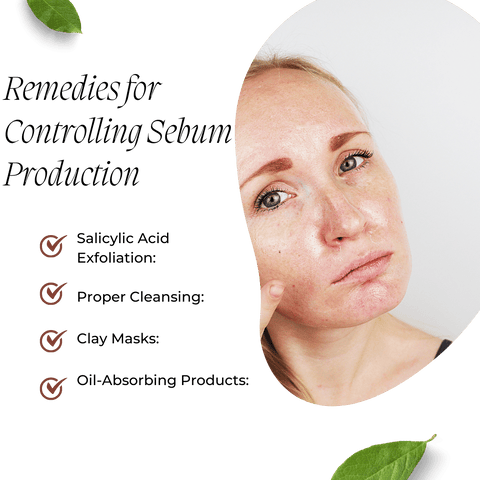
Controlling sebum production is a typical goal for those who have oily skin or want to control disorders like acne. While it is not possible (or desirable) to entirely eliminate sebum production, there are various effective cures and tactics to help balance sebum levels and maintain a more matte and clear complexion. Here are some home treatments for reducing sebum production:
-
Proper Cleansing: Wash your face twice a day (morning and night) with a gentle, sulfate-free cleanser to remove excess sebum, grime, and pollutants. Avoid strong or abrasive cleansers, which can peel the skin and potentially increase sebum production.
-
Salicylic Acid Exfoliation: Salicylic acid is a beta-hydroxy acid (BHA) that has the ability to permeate oily pores. It exfoliates the skin's surface, eliminating dead skin cells and preventing pores from becoming clogged. Use a salicylic acid-based exfoliator (e.g., toner or serum) 2-3 times per week.
-
Oil-Free, Non-Comedogenic Skincare Products: Choose non-comedogenic (non-pore-clogging) skincare products such as moisturisers, sunscreen, and makeup that are oil-free and non-comedogenic. Look for "non-comedogenic" products to ensure they won't aggravate sebum-related disorders.
-
Oil-Absorbing Products: Throughout the day, use oil-absorbing products like blotting sheets or oil-control powders to eliminate excess sebum without interfering with makeup.
-
Clay Masks: Once a week, use a clay mask to help absorb excess oil and pollutants from the skin. Clay masks with substances such as kaolin or bentonite can be especially beneficial.
-
Hyaluronic Acid-Based Moisturisers: Hyaluronic acid is a moisturising and lightweight chemical that may moisturise the skin without adding more oil. To keep your skin hydrated, use hyaluronic acid-based moisturisers.
-
Mattifying Sunscreen: Choose a sunscreen with a matte texture to help control shine throughout the day. Look for "oil-free" or "matte" sunscreen formulas.
-
Balanced Diet: Maintain a well-balanced diet rich in fruits, vegetables, lean proteins, and whole grains. Limit your intake of high-glycemic foods, sugary snacks, and dairy products, which may contribute to sebum overproduction.
-
Stay Hydrated: Drink enough water to stay hydrated, as dehydration can occasionally cause an increase in sebum production.
-
Stress Management: Stress can be reduced by using relaxation techniques, exercise, meditation, or mindfulness practises. Chronic stress may have an impact on hormone levels and sebum production.
-
Consult a Dermatologist: Consult a dermatologist if you have persistent problems with sebum production, acne, or other skin conditions. They can make personalised recommendations and, if necessary, administer topical or oral medications.
Natural Ingredients to Absorb Excess Sebum
Several natural substances can aid in the absorption of excess sebum and the regulation of oiliness on the skin. These substances are frequently found in skincare products and can be used to make homemade masks and treatments. Here are a few natural substances with oil-absorbing properties:
-
Clay: Clays like kaolin, bentonite, and French green clay are excellent natural absorbers of excess sebum. They can be used to draw out impurities and reduce oiliness in clay masks.
-
Oatmeal: Ground oatmeal can be used as a natural exfoliant and oil absorber. It removes dead skin cells and excess sebum, leaving the skin soft and matte.
-
Activated Charcoal: Activated charcoal has a porous structure that can absorb oil and impurities from the skin's surface. It is frequently used in skincare products such as masks and cleansers.
-
Rice Powder: For centuries, rice powder has been used in traditional Asian skincare. It has the ability to absorb oil, brighten the skin, and provide a smooth finish.
-
Witch Hazel: Witch hazel is a natural astringent that can help tighten pores and reduce excess oil production.
-
Aloe Vera Gel: Aloe vera gel soothes and hydrates the skin. While it does not directly absorb oil, it can help regulate sebum production and reduce inflammation.
-
Lemon Juice: Citric acid in lemon juice has a mild astringent impact and can help decrease oiliness. It should, however, be used with caution because it can be drying to some skin types.
-
Tea Tree Oil: Tea tree oil contains antibacterial qualities and can aid in the regulation of excessive oil production. It is frequently used as a spot treatment for acne-prone skin when diluted.
-
Cornflour: Cornflour can be used as a natural powder to absorb excess oil and reduce shine.
-
Apple Cider Vinegar: Distilled with water, apple cider vinegar can be used as a toner to help balance the pH of the skin and reduce oiliness. It should be used sparingly and with caution, as it can irritate some people.
Balancing Sebum Levels with Proper Cleansing
Proper washing is essential for keeping healthy skin and managing sebum levels. You may successfully remove extra sebum, grime, and pollutants from your skin without depriving it of its natural oils by using the correct cleansing routine. Use a gentle cleanser, prevent overwashing, warm water, a gentle cleansing method, double cleansing, non-comedogenic products, exfoliation, a balanced PH cleanser, pat dry, moisturise, and maintain consistency when cleansing to regulate sebum levels. Consider seeing a dermatologist if you have specific concerns about oiliness or skin disorders like acne. They can make tailored recommendations and treatments to help balance sebum levels and satisfy your specific skincare requirements.
Moisturizing Strategies for Sebum-Prone Skin
Moisturising is an important step in skincare, even for people with oily or sebum-prone skin. While adding moisture to oily skin may seem paradoxical, the correct moisturising tactics can help regulate sebum levels, preserve skin health, and avoid oil overproduction. Choose an oil-free moisturiser, gel-based moisturisers, or hyaluronic acid; use a moisturiser with niacinamide or non-comedogenic products; apply sparingly; use the targeted application; moisturise after cleansing; use SPF protection; use oil control paper; avoid harsh ingredients; maintain a consistent routine; and consult a dermatologist. You may attain a healthy and balanced complexion by following these moisturising tactics and selecting appropriate products.
Lifestyle Tips to Manage Sebum for Healthy Skin
Aside from skincare routines and product selection, several lifestyle changes can help manage sebum production and promote healthy skin. Incorporating these behaviors into your daily routine will help you achieve a more balanced complexion and lower your risk of skin problems caused by excess oiliness. Here are some lifestyle recommendations for controlling sebum and maintaining good skin:
-
Maintain a Balanced Diet: Consume a diet rich in fruits, vegetables, lean proteins, and whole grains. Limit your intake of high-glycemic foods, sugary snacks, and dairy items, as they can all influence sebum production and acne.
-
Stay Hydrated: Stay hydrated by drinking plenty of water. Even for people with oily skin, proper hydration is necessary for general skin health.
-
Manage Stress: Chronic stress may have an impact on hormone levels and sebum production. Incorporate stress-reduction activities such as meditation, deep breathing, yoga, or mindfulness practises into your daily routine.
-
Regular Exercise: Exercise on a regular basis can help regulate hormones and improve blood circulation, both of which can benefit the skin.
-
Get Sufficient Sleep: Aim for 7-9 hours of uninterrupted sleep per night. A lack of sleep can disrupt hormonal balance and have a negative impact on skin health.
-
Clean Bedding and Pillowcases: Change your bedding and pillowcases on a regular basis to prevent the accumulation of oil, dirt, and bacteria on your skin while you sleep.
-
Shower After Exercise: Shower immediately after exercising to remove sweat, bacteria, and excess oil from the skin's surface.
-
Keep Your Hands Off Your Face: Touching your face with your hands can transfer oils, dirt, and bacteria to your skin, potentially causing breakouts.
-
Limit Makeup Use: Allow your skin to breathe by not wearing makeup on days when you do not need it. When you do wear makeup, make sure it is non-comedogenic and oil-free.
-
Sun Protection: To protect your skin from UV rays, apply a broad-spectrum sunscreen every day. Sunscreen can also aid in the prevention of skin damage, which can result in increased sebum production.
-
Regularly Clean and Replace Makeup Brushes: Clean your makeup brushes and applicators regularly to prevent the buildup of bacteria and oil. Brushes should be replaced as needed.
-
Avoid Hot Water: When washing your face or showering, use lukewarm water rather than hot water, as hot water can strip the skin of its natural oils.
-
Seek Professional Help: If you have persistent concerns about excessive sebum production, acne, or other skin issues, see a dermatologist. They can provide you with tailored advice and treatments based on your specific needs.
Conclusion: Achieving Balanced Sebum Production for Healthy Skin
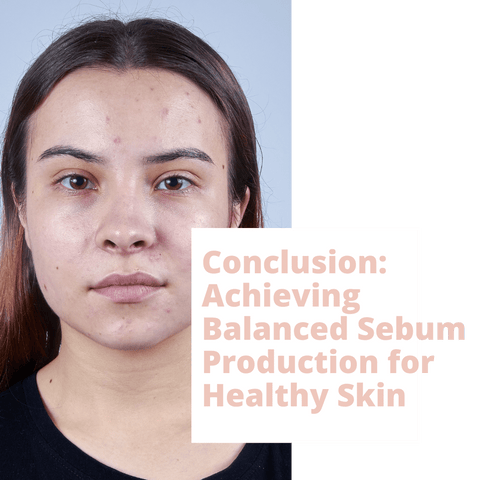
Maintaining healthy, clear skin requires controlled sebum production. Sebum, the skin's natural oil, is essential for skin health but can be harmful if overproduced. You may promote balanced sebum production and enjoy healthier skin by using a well-rounded approach that includes proper skincare practises, lifestyle changes, and the use of appropriate products. Here's a rundown of the main points: thorough washing, moisturiser, sun protection, exfoliation, balanced diet, hydration, stress management, clean bedding, restricted makeup use, skincare consistency, and professional advice. It's critical to be patient and make adjustments based on your skin's specific requirements. By following these suggestions, you can improve the health of your skin and get a more balanced and beautiful complexion.















